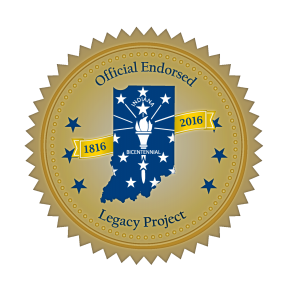IF THE RIVER COULD TALK
RIVER FORDS
Not Simply Getting to the Other Side
During the pioneer era, heavily used fords were occasionally equipped with a post, or some other object to indicate the river's depth to one unfamiliar with the ford. If the marker showed a higher than normal water level, it served as a warning to the unknowing traveler.
If the river could talk, it would tell of the numerous fords that were used in Madison County, first by a wide variety of animals that once roamed the forests here. Their pathways worn down over centuries of use, later served the Native American populations, both prehistoric and historic, that hunted and lived here. As time went on, trappers and traders appeared, and they too followed the pathways that led to the river and its fording sites.
A Dozen Fords
Where are the fords? If the river could talk, it would reveal the presence of 12 known fords in our county. From the point where White River enters Madison County, the first ford does not appear for nearly two miles downstream. Known for years as the Bronnenberg Ford, it derived its name like so many of the fords from a nearby landowner.
Today, the site of the ford is about a mile northwest of Chesterfield near the intersection of County Roads 300 East and 75 North. About a mile downstream from it was the Larmore Ford. Mr. J. Larmore owned 10 acres on the right bank of White River where the ford was located. Today, Anderson's East 10th Street ends near the Tanglewood Conference Center. A number of years ago, the street extended to the river and crossed to the other side.
If the river could talk, it would tell of the old iron bridge that carried horses and buggies and later vehicular traffic across White River. That bridge site was the location of the Larmore Ford.
The next ford was a major crossing as early as 1836, as it served farmers living northeast of the river. They would cross the river at the ford en route to the Jackson Mill located at the ford to have their grain ground into meal. If the ford had a name early on, it is unknown. By the 1870s it was known as the Myers Ford and was located beyond the end of today's East Lynn Street.
In 1876, Mr. S. Myers owned 117 acres on the river's right bank that encompassed all the area west of Scatterfield Road, north to Tenth Street, and west including all of th4e land that is Edgewater Park to the river's edge.
Two unique tales have survived related to the Myers Ford.
Getaway Route
Word soon spread that Democratic city officials were arresting and incarcerating Republican boys. The angry crowd went to the jail intent on tearing it down and setting them free. Cooler heads soon prevailed with the jail intact and the level of excitement reduced. However, Henry Bronnenberg was in town that day and someone reported that he had shouted something in support of Jefferson Davis, the former President of the Confederate States of America.
The crowd now turned on him, but he was riding a gray mare that purportedly could outrun the wind. He took for home with hundreds of fellows on foot and horseback following. If the river could talk, it would tell of Henry reaching its banks and crossing at the Myers Ford making his getaway, but not before firing his revolver at his pursuers.
Elephant Bath
If the river could talk, it would recall how the pachyderms rolled and tossed and made big waves and squirted each other by blowing water out of their trunks. It would not be the only time an elephant was in White River, but that's another story to be told later.
Stephen T. Jackson, Madison County Historian

Throughout Indiana's Bicentennial year of 2016, Steve Jackson, Madison County Historian, will be authoring "If The River Could Talk." This series will feature people, places, and events that takes place in and around White River.
The series is an officially endorsed legacy project of the Indiana Bicentennial Commission.
Madison County Historical Society|15 West 11th Street, P. O. Box 696, Anderson, Indiana 46015-0696|(765)683-0052|madisonchs10@gmail.com